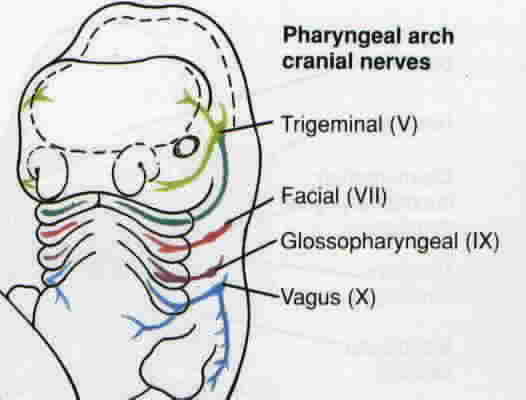
Usage: Many facial expressions derive from muscles and nerves of the pharyngeal arches. Early in Nonverbal World, pharyngeal arches were programmed to constrict in response to potentially harmful chemical signs detected in seawater. Today, paleocircuits (consisting of special visceral nerves) mediate displays of emotion by causing our branchiomeric muscles to contract.
Embryology. Pharyngeal arches are visible as swellings in the throat of the human fetus. Radical changes take place as these tissues grow into our maturing neck and face, but the underlying principles of movement established in the jawless fishes remain much the same: Unpleasant cues cause cranial nerves to constrict our eye, nose, mouth, and throat openings, while more pleasant sensations dilate our facial orifices to incoming cues.
Anatomy. Seawater was pumped in and out of the early pharynx through a series of gill slits at the fish's head end. Each pharyngeal arch contained a. a visceral nerve and b. a somatic muscle to open or close the gill opening (should, e.g., positive or negative signs, respectively, be sensed). In human beings, the nerves and muscles used to close the mouth derive from the 1st pharyngeal arch, while those which constrict the throat derive from the 3rd and 4th arches. From the 2nd pharyngeal arch, the facial nerve (cranial VII) contracts a. orbital muscles to narrow the eyes, b. corrugator and associated muscle groups to lower the eyebrows, and c. orbicularis oris muscles to seal the lips, should we detect, e.g., a noxious or disgusting smell.
RESEARCH REPORT: "It is evident that the primitive vertebrate pharynx was a device for filtering food out of a respiratory water stream and that in lower vertebrates it still is" (Kent 1969:10).
See also AROMA CUE, TASTE CUE.
Copyright 1998 - 2016 (David B. Givens/Center for Nonverbal Studies)
Illustration copyright 1991 by Appleton & Lange, Norwalk, Connecticut (Principles of Neural Science)